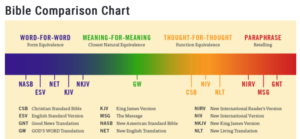
Is The KJV Inspired?
Is The KJV Inspired?
…do not turn aside from any of the words which I command you today, to the right or to the left, Deut. 28:14a
When you read verses like the one above, it begs the question—how accurate are the words in the Bible? If we’re going to stake our lives on the written Word, which English version of the Bible should I be learning from?
Susie and I became Believers in the 1970s and first attended a small Baptist church in Vestavia Hills, Alabama. Being good Independent Baptists they made sure we used the King James Version of the Bible (KJV).
We were basically taught it was sinful to use anything but the KJV. So a lot of the early verses we learned were in the King James  vernacular.
vernacular.
After a couple of years we changed churches and began attending a Bible church that used the New American Standard Bible version (NASB).
There we learned that the KJV was not God-inspired any more than one particular French version was God-inspired. Or Korean. Or German.
The only version that was inspired by the Lord was the original Hebrew and Greek manuscripts. And regardless of which translation you’re using, the words are all traced back to those original transcripts.
Changing Bible versions was a major change for us and we’ve benefited tremendously from switching to the NASB. But even today I sometimes have to computer-search for a verse using a KJV or NKJV translation because the key words I originally learned are from that translation.
The KJV IS a good, word-for-word, honest, literal translation that  was completed in 1611. It’s been updated and corrected over ten times—the last was the NKJV in 1982.
was completed in 1611. It’s been updated and corrected over ten times—the last was the NKJV in 1982.
The original KJV, including all its following updates, modifications, and corrections, was originally translated based on one manuscript called the Textus Receptus.
The Textus Receptus is a Latin, word-for-word, New Testament translation and was compiled by several scholars (mainly spearheaded by Dutch Erasmus) in the 16th century using eight Byzantine manuscripts.
Erasmus mainly used one manuscript, called Manuscript 2105. The original German “Luther Bible,” the English “Tyndale Bible,” and the “King James Bible” were all based on the Textus Receptus.
Despite the MANY textual errors in the original Textus Receptus manuscript(1) it became the dominant Greek text of the New Testament for 250 years. It was basically the first widely printed version as the printing press era had just begun.
Several corrected versions were published prior to Erasmus’ death, and many more following. Eventually, better translations were researched and made available in the late 1800s.
The NASB is also a literal word-for-word translation begun in 1959 and completed in 1971, and updated in 1977 and 1995. It was translated comparing numerous manuscripts, all dated 100 to 2000 years(2) or more before the Textus Receptus was compiled.
The NASB is widely considered to be the most literal translation available today providing a precise translation of the original Hebrew, Aramaic, and Greek in familiar English language.
There are no original copies of the New Testament books available to read today. However, we do have some 5,800 complete or fragmented Greek copies of text that date back to the first century.
read today. However, we do have some 5,800 complete or fragmented Greek copies of text that date back to the first century.
Plus, we also have some 10,000 manuscript copies or pieces of copies in Latin and 9300 copies in other languages. There are over 2.6 million pages of Biblical text in just the Greek.
No two manuscripts are exactly alike. When you hand-write a book of the Bible on papyrus or animal skin, there are inevitably copyist errors of all kinds.
Jewish scribes and Catholic Monks did a commendable job of accurately reproducing the Biblical text through the centuries. But humans are fallible.
Therefore, since for 1000 years Bible manuscripts were hand-written, the oldest manuscripts to compare and translate the NASB allows for a more-accurate translation.
Wherever there is a manuscript difference, the NASB editors make note of the difference in the margin.
I’ve found the NASB to be more easily understood because it was translated in today’s language in 1977 (slightly revised in 1995) as opposed to the KJV from 1611.
There are other reasons to use the NASB and someone at biblesanity.org did a good job of outlining most of them. CLICK HERE to read what they say. 
Other non-literal translations like the NIV are referred to as dynamic equivalents or “thought for thought.” This means a person reads the Greek or Hebrew and writes down what they think the verse means.
Obviously, when you inject human reasoning into translating God’s Word to make it more readable, you’ve filtered God with human/sinful nature. Often that waters down the intended meaning.
I personally want to read what God said, not what someone thinks God said. I’ll let God’s Holy Spirit enlighten me to its meaning.
So it’s best to use Thought for Thought and Paraphrase Bibles as commentaries, not study Bibles.
Again, I think the KJV is a good translation…for some reason it even sounds Godly when you read it. But it’s not inspired by God. It has errors. All translations do.
Therefore, regardless of which translation you use, it’s best to spend a lot of time looking up words in the original languages—which WERE inspired by God.
With computers today you can get the original word in Greek and/or Hebrew by just hovering your mouse over the word.
When you consider that there are five times as many Greek words as English (up to one million English and five million Greek), translators often have had to use the same English word to translate several different Greek words.
An often-cited example is our English word “love.” I can say in English, “I love to play golf,” “a mother loves her children,” “I want to make love to my wife,” or “God loves me.” “Love” can mean a lot of different things.
But in the Greek those are all different Greek words. In fact, there are actually eight Greek words we translate into one English word, “Love.”
Eros is physical love or sexual desire.
Philia is affectionate/friendship love.
Agape is unconditional, sacrificial love.
Storge is love for family members.
Mania is obsessive/stalker love.
Ludus is playful, flirting, or noncommittal sexual love.
Pragma is practical love based on duty, obligation or logic.
Philautia is self-love, how one feels about their own self.
So when using Greek words to describe something, the meaning in the sentence is rarely missed.
Some Bible scholars go so far as to say God created the Koine Greek language (the common language of the day) specifically for accurately recording the meanings of His written Word. Makes sense to me.
I LOVE everyone reading this. Guess which love!
Use us, Lord!
